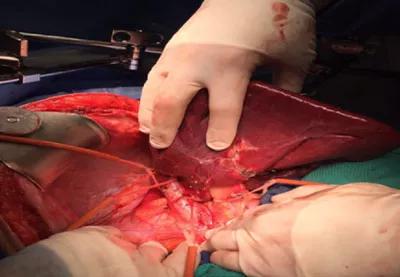Advertisement
Multidisciplinary critical care in the time of COVID-19

When clinicians across medical disciplines at Cleveland Clinic joined forces in 2018 to establish an evidence-based intensive care unit for patients with advanced liver disease, they built daily, in-person multidisciplinary collaborations into the model. Patients were triaged into a single geographical unit staffed by nurses trained in liver-specific protocols.
Advertisement
Cleveland Clinic is a non-profit academic medical center. Advertising on our site helps support our mission. We do not endorse non-Cleveland Clinic products or services. Policy
Their planning paid off, according to data shared during Digestive Disease Week in 2019. Patients admitted to the medical intensive liver unit (MILU) experienced a higher transplant-free survival rate (79.5%) compared with a survival rate of 70.8% among patients in the non-MILU group (P = 0.015).
“We were encouraged by our successes, while continuously fine-tuning our processes, and caring for the sickest patients,” says Aanchal Kapoor, MD, staff in the Department of Critical Care Medicine and Director of the MILU. “And then COVID-19 hit. Our space was needed for these very infectious patients, our highly trained staff were diverted and our core — frequent face-to-face collaboration among providers — was suddenly unsafe.”
As cases of COVID-19 surged, Christina Lindenmeyer, MD, Co-Director of the MILU and staff in the Department of Gastroenterology and Hepatology, and her team quickly trained a new nursing team and adapted to a new space. But patients were presenting sicker, including those with complications related to COVID-19, and throughput was an even greater challenge given COVID-19 transfer protocols.
“Most fields have seen an increase in case severity as a result of patients’ reluctance to put themselves at risk during a pandemic,” says Dr. Lindenmeyer. “But with liver transplantation candidates, one or two days can make the difference between staying active on the waitlist and becoming too sick to tolerate the procedure.”
Advertisement
Nationally, hospitals have seen an increase in the severity of illness for hospitalized hepatology patients over the course of the pandemic. MELD scores of patients admitted to the Cleveland Clinic MILU averaged 27.2 in the first year of operation (2018-2019); that rose to 30.1 in 2020. Although the number of patients cared for in the MILU was down from 436 in 2018-2019 to 373 in 2020, the transplant team performed more transplants than ever before in 2020.
“Over two-thirds of the patients who were admitted to MILU in 2020 and who were eventually transplanted were able to be transplanted directly from the MILU, compared with just over one-third of MILU patients transplanted in the prior year,” says Dr. Kapoor. “So although COVID-19 interrupted or altered most of our processes, we see evidence of faster transplant evaluations, enhanced multidisciplinary collaboration and communication and continuous improvement of our protocols. We are working harder to find pathways to safely transplant patients with critical care needs.”
Another impact of the pandemic? “Our number of patients presenting with alcohol-related liver disease rose by almost 10 percent,” says Dr. Lindenmeyer.
The initial success of the MILU depended in large part on continuous communication among all providers –hepatologists, critical care physicians, infectious disease specialists, surgeons, nephrologists, neurologists, social workers, nurses, dieticians and pharmacists.
Advertisement
“We tried our best to mimic that hallway conversation that can be so critical to what we do in a COVID-safe way,” says Dr. Lindenmeyer. “We standardized and expanded our morning huddle, implemented breakout panels for subspecialty teams and transitioned to virtual co-rounding. We utilized iPads dedicated to bring colleagues along on the rounds virtually, and we continued our working groups to revise guidelines on indications for initiation of dialysis, nutrition optimization, antibiotic choices in the setting of sepsis and advances in the care of patients with acute liver failure.”
MILU patients in 2020 had a higher APACHE score as compared to previous years. “This patient population offers a complex hemodynamic challenge, and decisions about transplant have to be made in a very narrow window,” says Dr. Kapoor. “We leveraged virtual technology to stay connected, closely monitoring and co-managing these patients, continuing the transplant workup and optimizing patients for surgery. It was amazing to see patients with MELDs in the high 30s get transplanted within 48 hours.”
The working groups formed to increase collaboration while decreasing physical contact have become a critical part of MILU infrastructure. The teams reassessed all prior unit protocols and are now working on standardizing them. The unit also recently acquired a Molecular Adsorbent Recirculating System (MARS®) to enhance the albumin dialysis and plasmapheresis programs.
The team is also reaching beyond the unit, applying their knowledge to the development of standard criteria for transplantation. “Right now, we have limited evidence to guide us when a patient is too sick to be a viable candidate for transplant,” says Dr. Lindenmeyer. “But we’ve built a successful unit based on protocols developed by a carefully crafted multidisciplinary team, and we plan to host an international symposium in 2022 to share that knowledge.”
The MILU is also maintaining a prospective registry of patients to study outcomes and develop novel research protocols that could potentially revolutionize the care of critically ill patients with liver disease.
“It took a long time to get us to this point,” she adds. “But with constant reassessment, we’ve all found common ground in the best interest of our patients.”
To arrange a patient transfer, call 216.444.8302 or 800.553.5056.
Advertisement
Advertisement

Patients report improved sense of smell and taste

Clinicians who are accustomed to uncertainty can do well by patients

Unique skin changes can occur after infection or vaccine

Cleveland Clinic analysis suggests that obtaining care for the virus might reveal a previously undiagnosed condition

As the pandemic evolves, rheumatologists must continue to be mindful of most vulnerable patients

Early results suggest positive outcomes from COVID-19 PrEP treatment

Could the virus have caused the condition or triggered previously undiagnosed disease?

Five categories of cutaneous abnormalities are associated with COVID-19